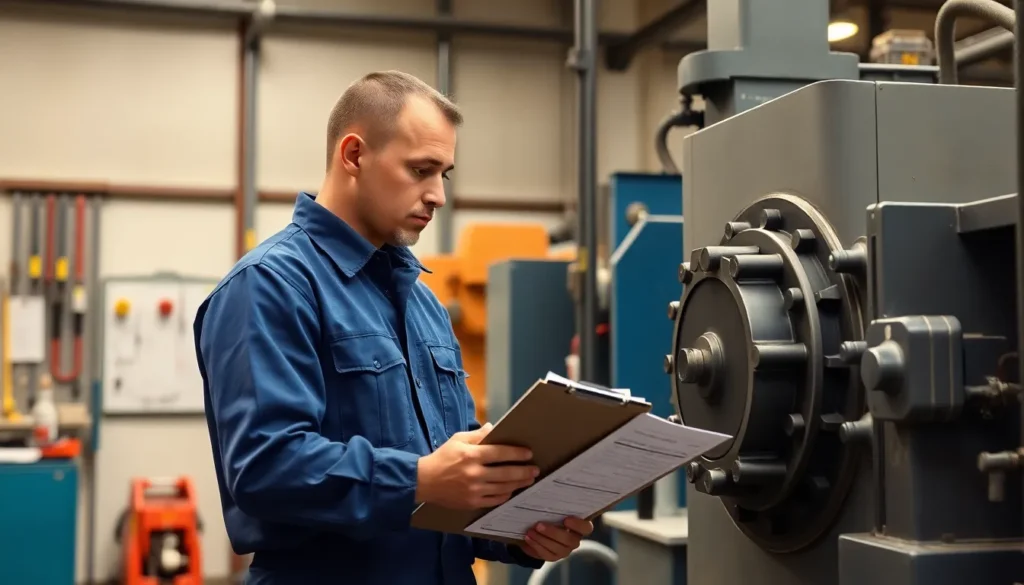In a world where everything seems to break down at the most inconvenient times, preventative maintenance checklists are like the superhero sidekicks we never knew we needed. They swoop in to save the day, ensuring that equipment and systems run smoothly while keeping costly repairs at bay. Who wouldn’t want to avoid that heart-stopping moment when the coffee machine breaks right before Monday morning meetings?
Think of these checklists as your trusty roadmap through the wild terrain of maintenance. They guide you step-by-step, ensuring nothing gets overlooked. With a little humor and a lot of savvy, embracing preventative maintenance can transform your operations from chaotic to streamlined. So why not dive in and discover how these checklists can make your life easier, one task at a time?
Table of Contents
ToggleImportance Of Preventative Maintenance Checklists
Preventative maintenance checklists play a crucial role in enhancing operational efficiency. They ensure that equipment and systems receive regular attention, thereby minimizing unexpected failures. A structured checklist helps technicians systematically approach maintenance tasks, reducing the likelihood of oversight.
Utilizing these checklists can lead to significant cost savings. It’s noted that organizations reduce repair expenses by up to 30% through regular maintenance. The checklists provide a clear outline of tasks, making it easier to prioritize critical maintenance activities.
Effective communication is fostered by having a checklist. Team members can clearly understand their responsibilities and maintain accountability. Collaboration is enhanced when everyone follows a uniform process, leading to improved workflow.
These checklists raise awareness about potential issues before they escalate. Identifying minor problems early can prevent major breakdowns and lengthy downtimes. Consistent use allows for data collection and analysis, helping in forecasting future maintenance needs.
Documentation of completed tasks can provide valuable insights. This historical data enables better decision-making about equipment replacement or upgrades. Companies that adopt preventative maintenance checklists often report increased equipment lifespan.
Employers often notice a boost in employee morale when equipment runs smoothly. Reduced frustration from unexpected breakdowns leads to a more productive work environment. Prioritizing preventative maintenance ultimately supports organizational goals and improves overall performance.
Components Of A Preventative Maintenance Checklist

Preventative maintenance checklists consist of several key components that ensure thorough upkeep of equipment. Each component addresses specific aspects necessary for effective maintenance management.
Routine Inspection Tasks
Routine inspection tasks include visual checks, functionality tests, and performance evaluations. Regularly inspecting equipment helps identify signs of wear or damage early on. Examples of routine tasks are checking fluid levels, inspecting belts and hoses, and testing electrical connections. Consistency in these inspections promotes proactive maintenance, reducing the likelihood of costly repairs.
Maintenance Scheduling
Maintenance scheduling is crucial for organizational efficiency. Scheduling tasks at regular intervals helps maintain a steady workflow. Utilizing a calendar or software application enables managers to track due dates and allocate resources effectively. High-priority tasks typically receive more frequent attention, reducing downtime and ensuring that critical equipment remains operational.
Documentation Requirements
Documentation requirements play a significant role in effective preventative maintenance. Keeping records of completed tasks, inspection results, and scheduled maintenance activities is essential. Documentation provides data for analysis, helping identify trends or persistent issues. Clear records facilitate better decision-making regarding future maintenance strategies and equipment replacement.
Benefits Of Using Preventative Maintenance Checklists
Preventative maintenance checklists offer numerous benefits that contribute to organizational efficiency and effectiveness. These structured tools enhance various aspects of maintenance management.
Cost Savings
Implementing preventative maintenance checklists leads to notable cost savings for organizations. Reports indicate that companies can reduce repair expenses by up to 30% through consistent maintenance. Regular inspections help identify minor issues before they escalate into costly repairs, minimizing financial impact. Furthermore, the checklists streamline maintenance tasks, allowing for better resource allocation and time management. By optimizing workflows, teams avoid unnecessary delays and expenses, enhancing overall productivity. Investing in preventative practices not only safeguards equipment but also reinforces financial stability within the organization.
Increased Equipment Lifespan
Utilizing preventative maintenance checklists significantly extends the lifespan of equipment. Regular attention helps identify signs of wear and tear early, allowing timely repairs before major breakdowns occur. This proactive approach prevents equipment from falling into disrepair, thereby ensuring reliable performance over time. Consistent maintenance fosters a healthier operating environment, leading to fewer interruptions in workflow. Improved equipment functionality enhances productivity and morale among employees, as they work with reliable tools. Organizations that prioritize preventative maintenance initiatives often experience prolonged asset life, contributing to sustainable operational success.
Creating An Effective Preventative Maintenance Checklist
Establishing an effective preventative maintenance checklist requires careful planning and organization. Start by outlining routine inspection tasks, which include visual checks, functionality tests, and performance evaluations. These tasks help early identification of signs of wear or damage, preventing bigger issues down the road.
Next, prioritize maintenance scheduling to maintain workflow consistency. Utilize a calendar or digital tool to track due dates, ensuring timely execution of tasks. Effective scheduling allows managers to allocate resources wisely, avoiding chaos in operations.
Documentation plays a pivotal role in maintenance management. Create segments within the checklist dedicated to recording completed tasks and observations. These entries provide data for future analysis, helping refine maintenance strategies and making informed decisions regarding equipment replacement.
Incorporating a feedback loop enhances the checklist’s efficiency. Encourage team members to communicate potential issues and suggest improvements. This collaboration fosters a sense of ownership and leads to a more proactive maintenance culture.
Aim to include specific metrics for tracking performance. Quantifiable data helps assess the effectiveness of maintenance efforts over time. For instance, organizations that implement these practices might experience up to a 30% reduction in repair expenses.
Regularly reviewing and updating the checklist ensures its relevance. Equipment and operational needs may change, so staying flexible is essential. Adapting the checklist to these changes keeps maintenance practices aligned with organizational goals.
Ultimately, structuring a comprehensive preventative maintenance checklist enhances operational efficiency and prolongs equipment lifespan. Prioritization of these components simplifies complex tasks and contributes to a productive work environment.
Tips For Implementing Preventative Maintenance Checklists
Creating an effective preventative maintenance checklist begins with defined objectives. Identify specific goals for each task, ensuring the checklist aligns with overall operational priorities. Establish regular intervals for inspections and maintenance, promoting a consistent approach that keeps equipment in optimal condition.
Utilizing digital tools streamlines scheduling. Digital platforms allow easy tracking of due dates, facilitating better planning and resource allocation. Encourage team participation during the checklist development process. Input from various team members fosters a sense of ownership, increasing accountability and compliance when using the checklist.
Employ visuals within checklists whenever possible. Simple diagrams or photographs provide clear guidelines for inspection tasks, helping team members accurately assess equipment condition. Collecting data during each maintenance session is vital. This documentation supports future analysis, allowing for informed decision-making regarding equipment upgrades or replacements.
Regular reviews of the checklist are essential. Updating based on feedback or equipment changes ensures ongoing relevance and effectiveness. Share insights gained from checklist utilization with the entire team. Communication enhances collaboration, fostering a culture of continuous improvement.
Lastly, track performance metrics to measure maintenance effectiveness. Monitoring key indicators helps identify trends and areas for improvement, ultimately supporting cost-saving measures. Organizations adhering to these tips often experience enhanced operational efficiency and extended equipment lifespan, leading to a more productive work environment.
Preventative maintenance checklists are invaluable for any organization aiming to enhance operational efficiency. By integrating these tools into daily routines, teams can proactively address potential issues and ensure equipment remains in optimal condition. This approach not only minimizes unexpected breakdowns but also significantly reduces repair costs.
Embracing a structured maintenance strategy fosters a culture of accountability and collaboration among team members. As organizations prioritize preventative maintenance, they position themselves for long-term success, benefiting from improved productivity and employee morale. Ultimately, the consistent application of these checklists leads to smoother operations and a more resilient business environment.




